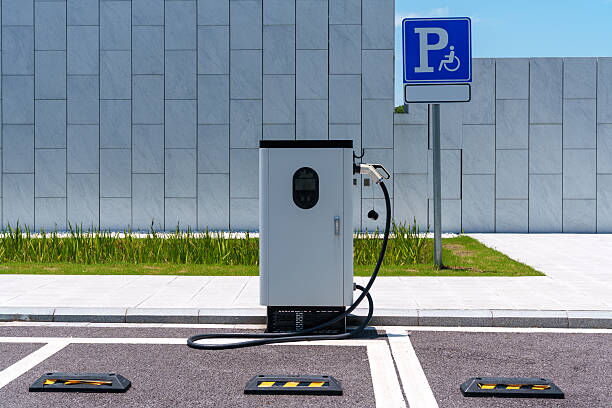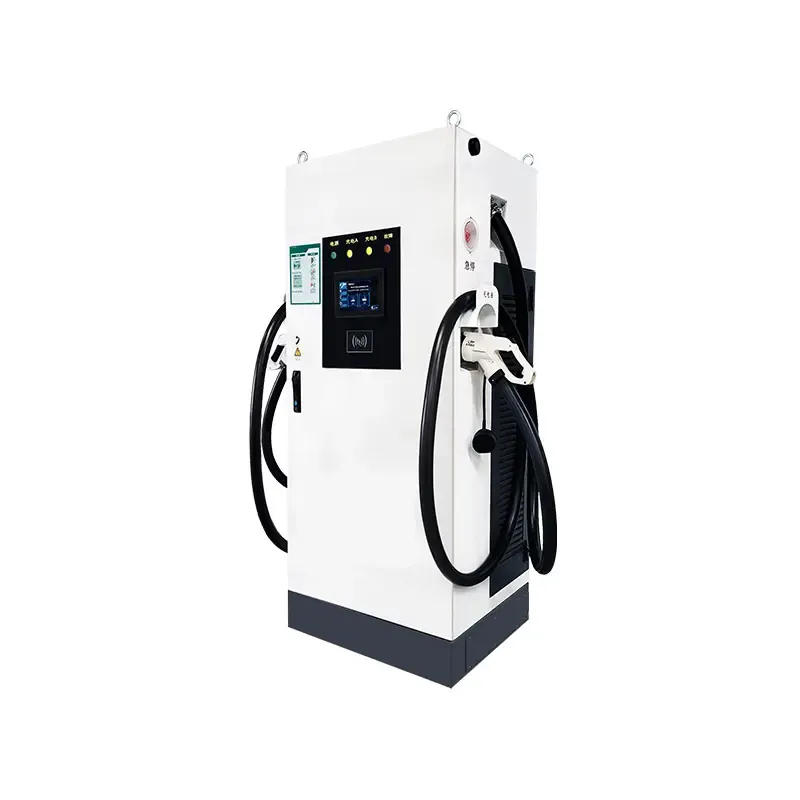As electric vehicles (EVs) continue to reshape the global transportation landscape, the demand for fast, reliable, and efficient charging infrastructure is growing rapidly. At the heart of this infrastructure is the DC charging pile—a powerful device designed to deliver high-speed charging for electric vehicles using direct current (DC).
Unlike traditional AC chargers that are often installed at residential properties and workplaces for overnight or slow charging, DC charging piles are engineered for speed and efficiency. These systems are typically deployed in public locations such as highway rest stops, shopping malls, service stations, and commercial parking lots, allowing EV drivers to quickly top up their batteries and get back on the road.
In this article, we will delve deep into the technical workings of DC charging piles, their structure, classification, advantages over AC charging systems, and the crucial role they play in the development of modern electric vehicle infrastructure.

A DC charging pile, also known as a DC fast charger or Level 3 charger, is a high-powered device that supplies direct current (DC) electricity directly to an electric vehicle’s battery. Unlike alternating current (AC) chargers that rely on the vehicle’s onboard converter to change AC into DC, DC chargers bypass this process, delivering electricity directly to the battery through a much faster and more efficient route.
This capability enables significantly faster charging times, often replenishing 80% of an EV's battery within 20 to 40 minutes, depending on the vehicle’s battery capacity and the charger’s power output.
The operation of a DC charging pile involves several key components working together in a coordinated manner. These include:
The primary function of the rectifier is to convert alternating current (AC), typically supplied by the power grid, into direct current (DC). This transformation is essential because EV batteries store and operate using DC electricity.
Once the power is rectified, the DC/DC converter steps in to adjust the voltage and current to appropriate levels based on the specific charging requirements of the connected vehicle. The converter ensures that the output parameters are suitable and safe for the EV's battery system.
The control unit is the brain of the DC charging pile. It is responsible for:
Monitoring the charging process
Communicating with the EV’s Battery Management System (BMS)
Managing safety protocols
Recording operational data and diagnostics
When an EV is plugged into the charger, a digital communication sequence occurs between the vehicle’s BMS and the charging pile’s control unit. This dialogue includes information such as:
Battery status (State of Charge, temperature, health)
Maximum allowable current and voltage
Charging duration and power capacity
Once the handshake is complete, the charging session begins, and the system continuously monitors conditions in real-time to ensure safety and efficiency.

DC charging piles can be classified into several categories based on their design, functionality, and intended application scenarios. The most common types include:
This type features a single charging connector (or “gun”) and is designed to charge one vehicle at a time. Single-gun chargers are suitable for locations with limited space or where vehicle throughput is relatively low.
Equipped with multiple charging connectors, multi-gun DC charging piles can serve several vehicles simultaneously. These are commonly installed in commercial or public charging stations where higher traffic volume demands more capacity.
Depending on the design, the charger may:
Charge multiple vehicles in parallel (with power evenly distributed), or
Charge in sequential mode, assigning full power to one vehicle at a time based on a queue system.
Modular designs allow for scalable configurations, where the number of power modules and charging ports can be adjusted according to site-specific requirements. This flexibility is particularly beneficial for operators who want to start small and expand infrastructure as demand grows.
Key advantages of modular DC chargers include:
Easier maintenance and repair
Efficient power management
Customizable charging capacity
The primary difference between DC and AC charging piles lies in how they supply power to the electric vehicle and the speed of the charging process.
|
Feature |
DC Charging Pile |
AC Charging Pile |
|
Power Supply |
Provides direct current (DC) |
Provides alternating current (AC) |
|
Charging Speed |
Fast (Level 3 charging, typically 50–350 kW) |
Slow to moderate (Level 1 or 2, 3–22 kW) |
|
Location |
Public charging stations, highways |
Homes, offices, parking lots |
|
Conversion Process |
External charger converts AC to DC |
Onboard vehicle charger converts AC to DC |
|
Use Case |
Quick top-ups during travel |
Overnight or routine daily charging |
In essence, DC charging piles reduce dependency on the onboard charger. Because the conversion happens externally at the charging station, they can supply significantly more power than AC units, making them the preferred choice for time-sensitive, high-demand charging scenarios.
As EV adoption accelerates, the advantages of DC charging piles are becoming increasingly clear. These include:
Perhaps the most prominent benefit is the ability to charge an EV to 80% capacity in less than an hour. This is particularly critical for:
Long-distance travelers
Commercial fleets
Taxi and ride-sharing services
For logistics companies and service providers that operate EV fleets, shorter charging times translate directly into increased vehicle availability and operational efficiency.
DC charging piles can be deployed in a wide range of locations:
Gas stations
Urban parking garages
Highway rest areas
Commercial zones and malls
Most modern DC charging piles are equipped with IoT and cloud connectivity, allowing:
Remote diagnostics
Real-time monitoring
Fault alerts
Firmware updates
User interaction via apps or smartcards
Advanced DC charging piles often support global EV charging standards such as:
CCS (Combined Charging System)
CHAdeMO
GB/T (China standard)
This multi-standard compatibility helps serve a broad range of vehicle models and brands.
DC charging piles are equipped with several protective and intelligent components to ensure both safety and performance:
Surge Protection Devices (SPD): Prevent damage from voltage spikes
Emergency Stop Buttons: Allow users to halt the process instantly
Cooling Systems: Keep internal components at optimal operating temperatures
Smart Meters: Monitor energy usage and billing data
Locking Mechanisms: Secure the charging cable during operation to prevent accidents or theft
In addition, the charging software is programmed to detect anomalies such as:
Overvoltage/undervoltage
Overcurrent
Short circuits
Ground faults
Communication errors
If any irregularities occur, the system immediately shuts down to prevent damage to the charger or vehicle.
While DC charging piles offer many benefits, several challenges hinder their widespread adoption:
Due to their high power capacity, DC chargers require:
Upgraded electrical infrastructure
Transformer and grid capacity
Civil engineering for installation
As a result, the capital expenditure is significantly higher than that of AC chargers.
Large-scale deployment of DC chargers can put a strain on the electrical grid, especially during peak hours. Smart grid integration and load balancing solutions are essential to prevent overload.
DC charging stations often need larger footprints for power cabinets, cooling systems, and vehicle maneuvering.
Due to their complexity and high power output, DC chargers require regular maintenance and occasional repairs. This includes checking power modules, cooling fans, cables, and firmware systems.
The future of DC charging is exciting and filled with innovations aimed at making EV charging faster, smarter, and more accessible:
Next-generation DC charging piles with power outputs of 350 kW and above will make it possible to add 200–300 km of range in under 10 minutes.
Advanced DC chargers will soon allow bidirectional power flow, enabling EVs to return energy to the grid during peak demand, supporting grid stability.
AI and machine learning can help optimize energy use, reduce grid pressure, and predict charging patterns to improve service availability.
Combining DC fast chargers with solar panels and battery storage systems offers a sustainable, off-grid charging solution for remote areas.
DC charging piles are an essential part of the modern EV charging ecosystem. Their ability to deliver high-powered, rapid charging is revolutionizing how electric vehicles are used and supported around the world. As technology continues to advance and EV adoption increases, DC chargers will play a central role in enabling long-distance travel, commercial EV fleet operations, and the broader goal of reducing carbon emissions.
Whether you're a driver, fleet manager, or energy provider, understanding the function and potential of DC charging piles is crucial to navigating the electric mobility future.
